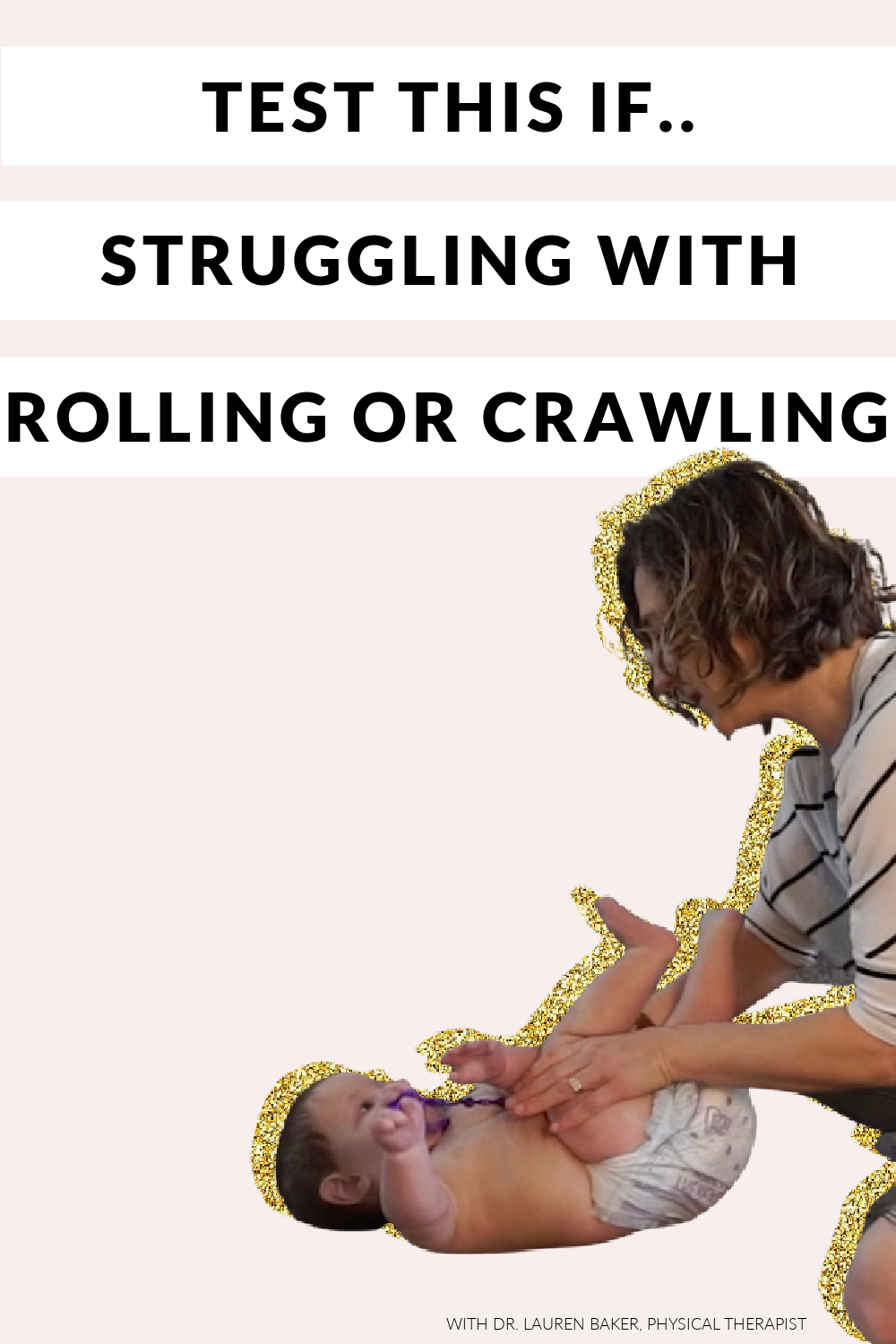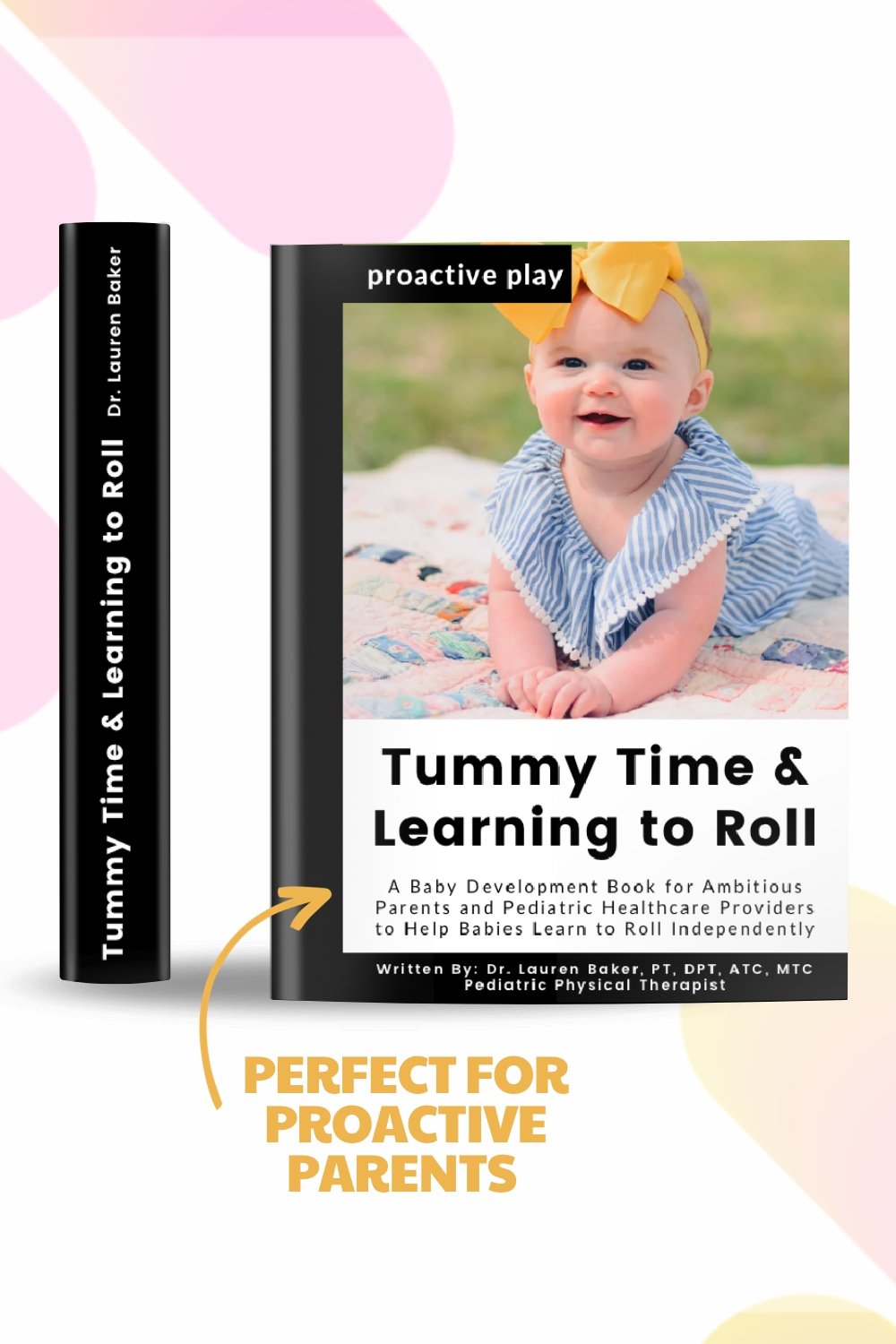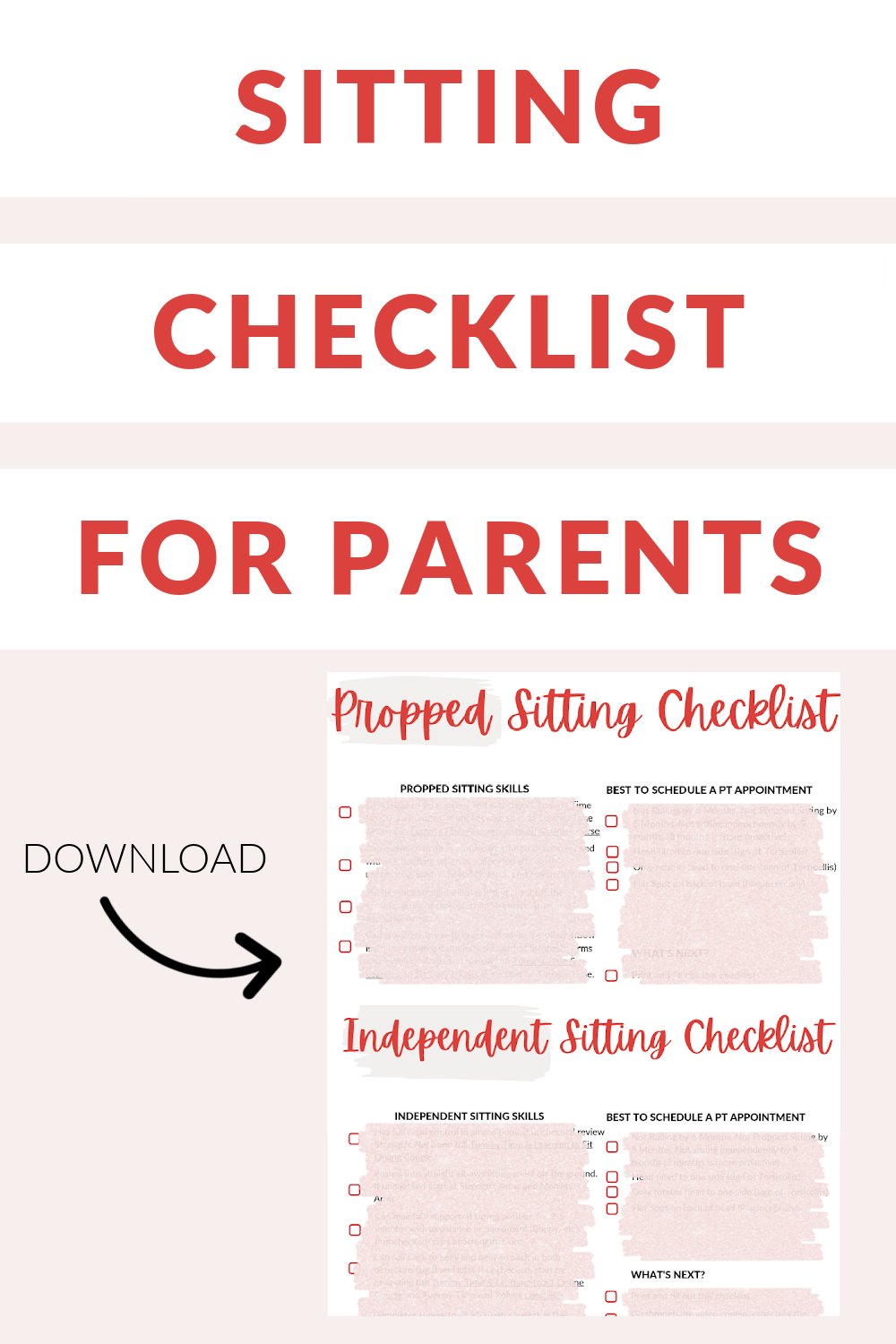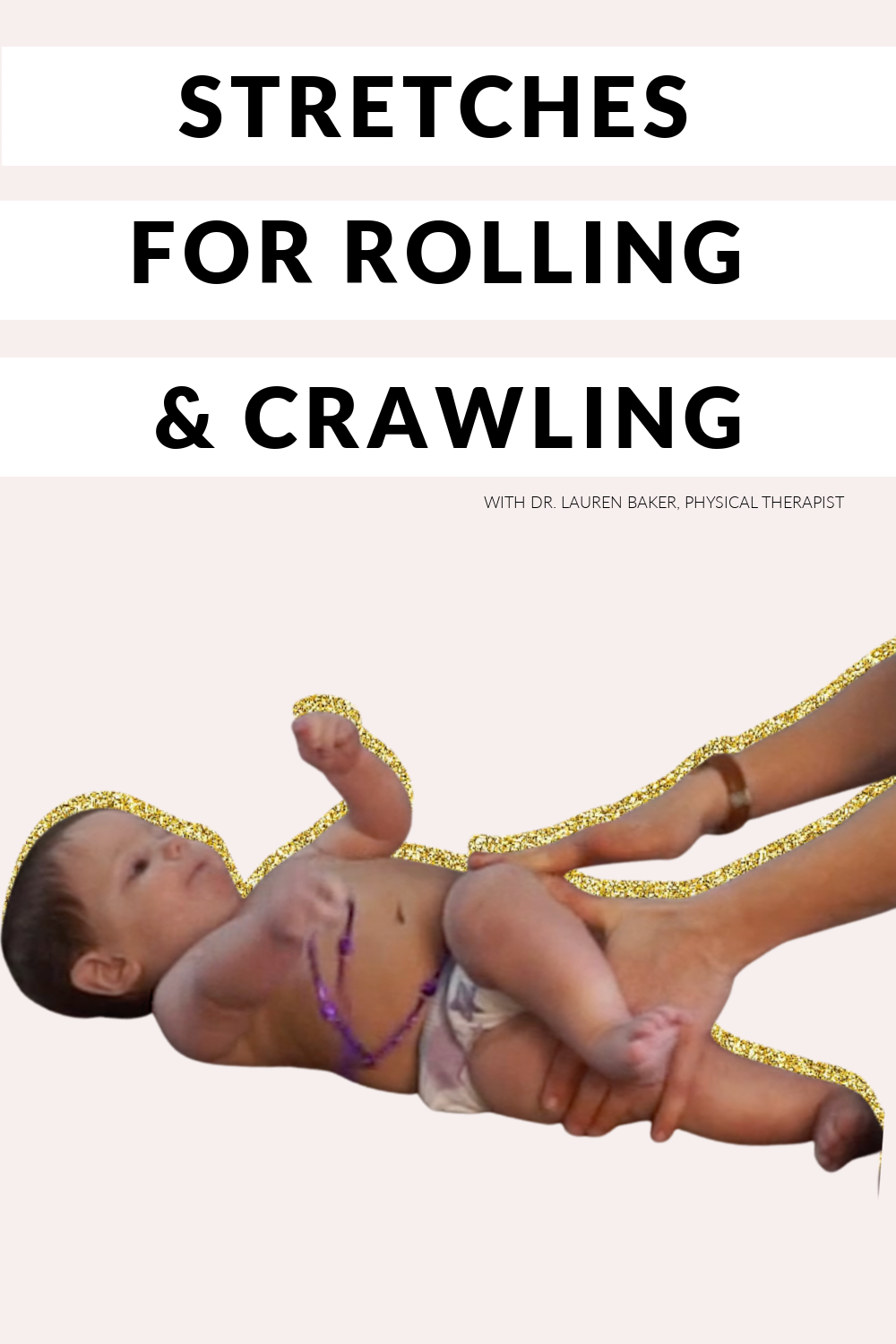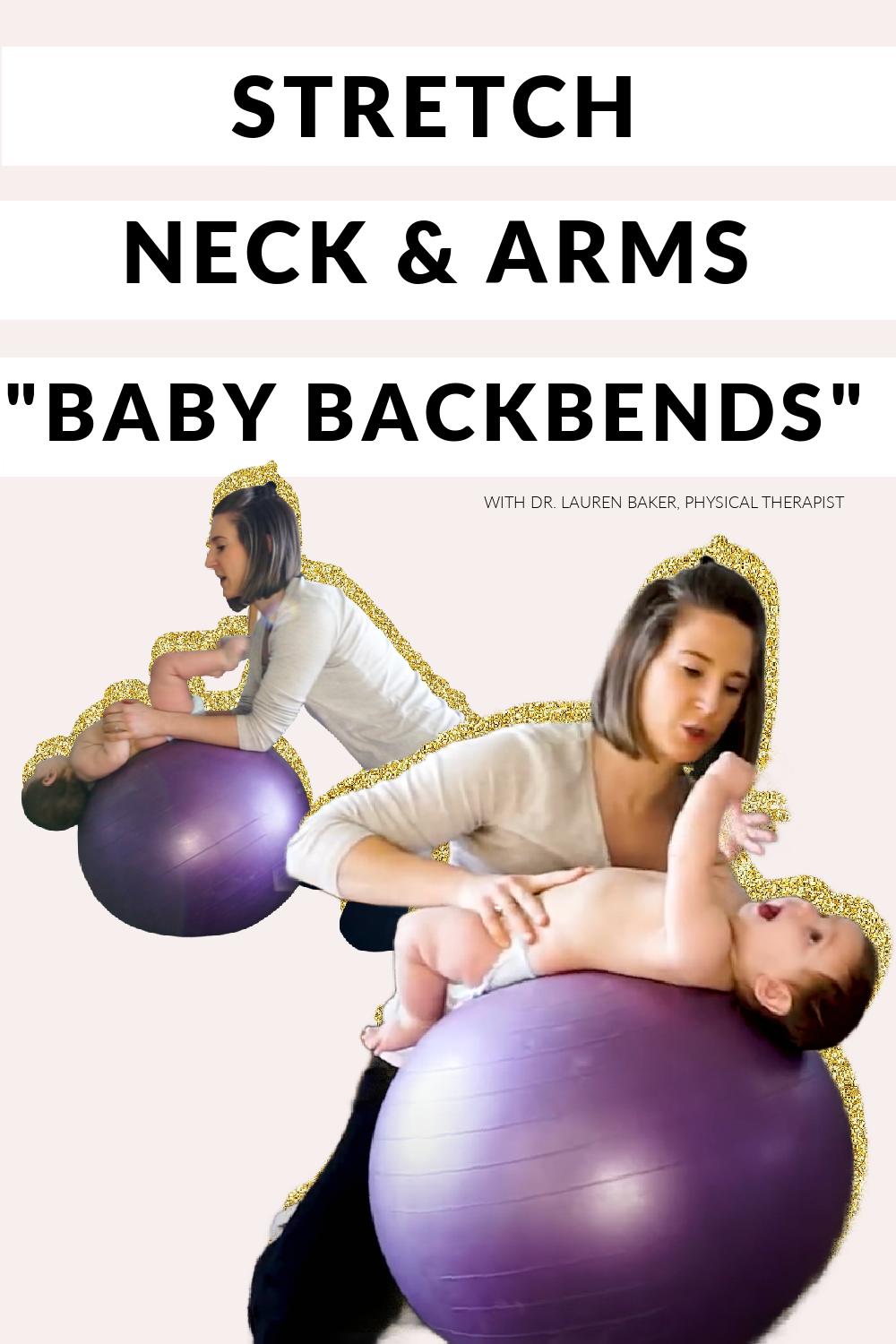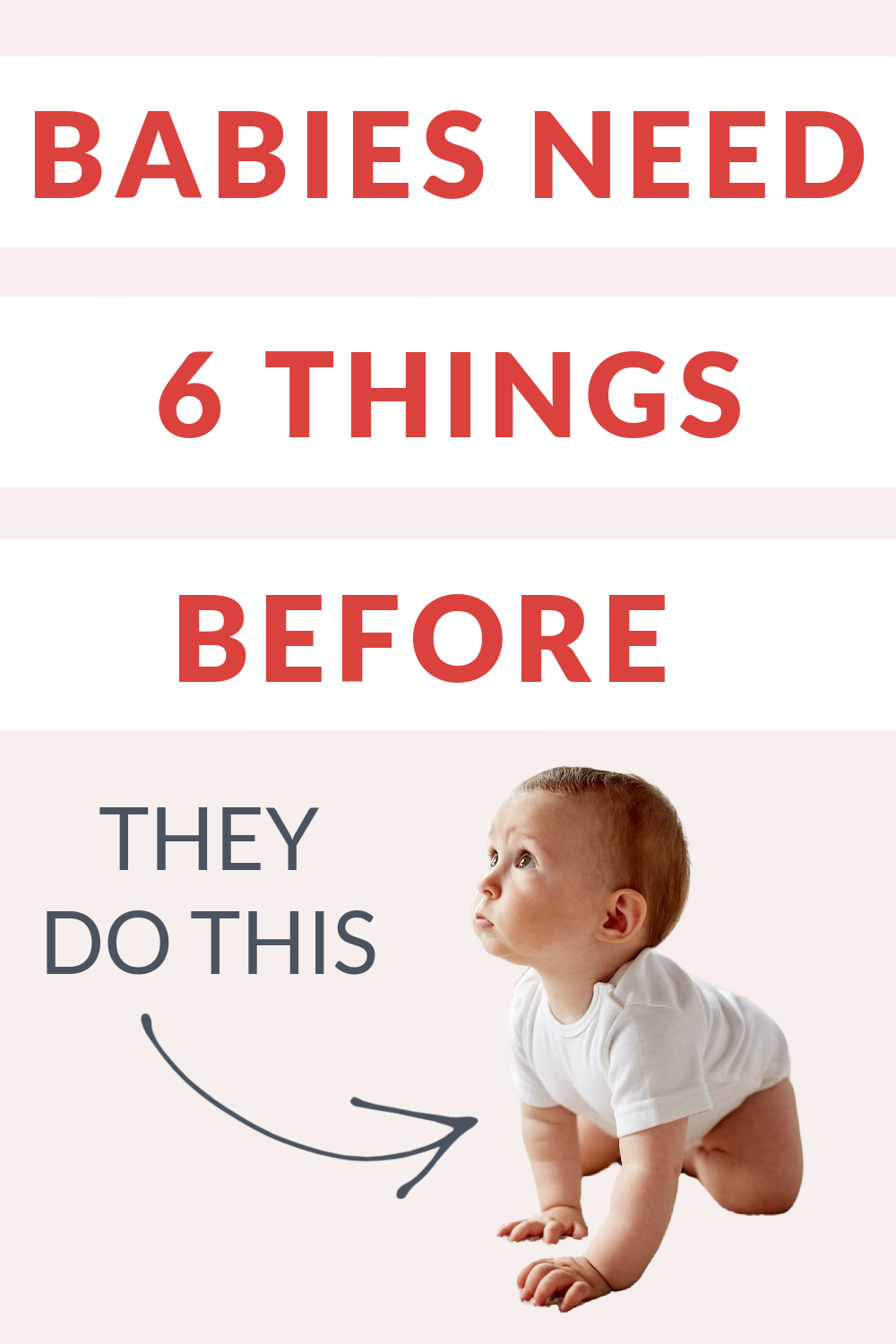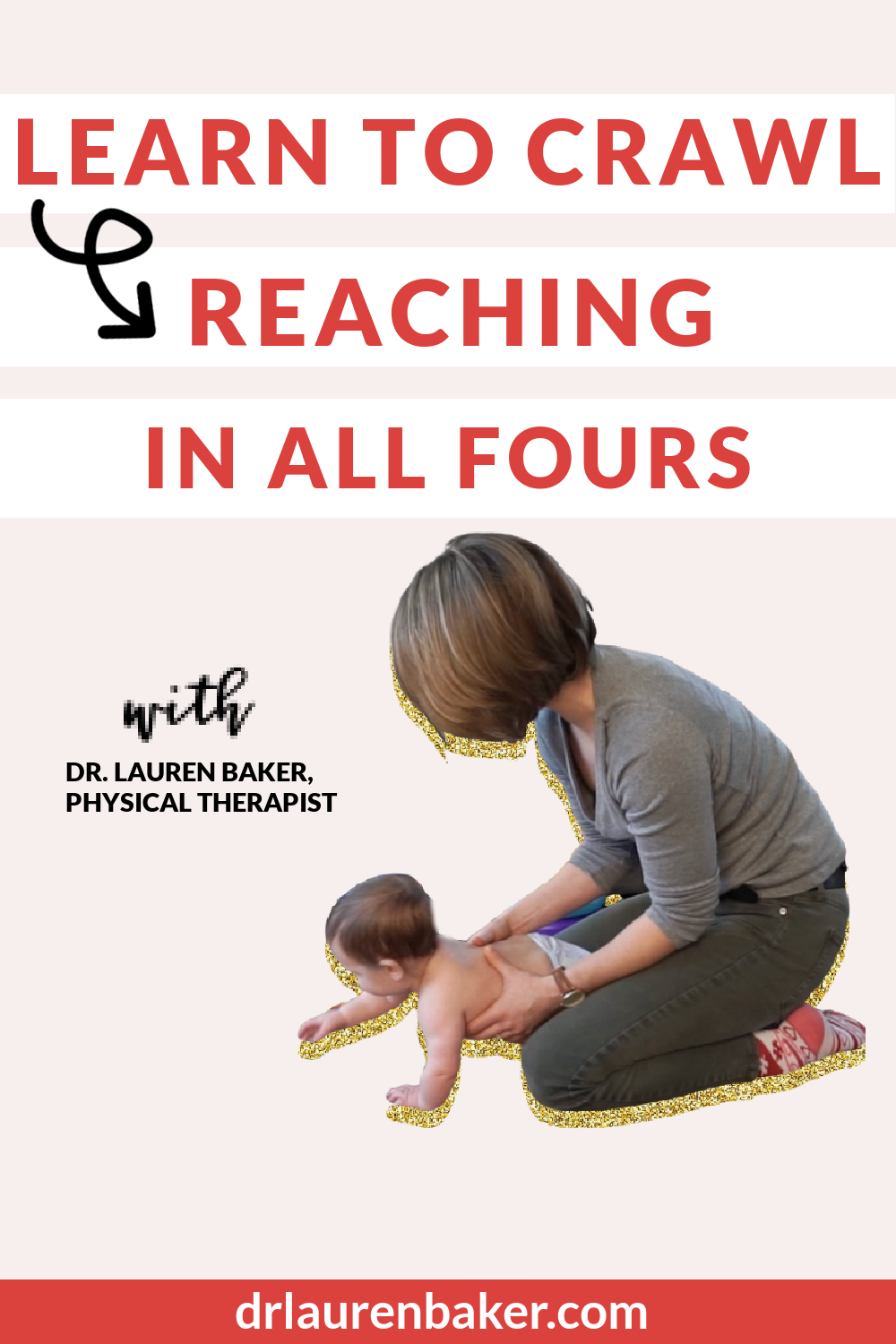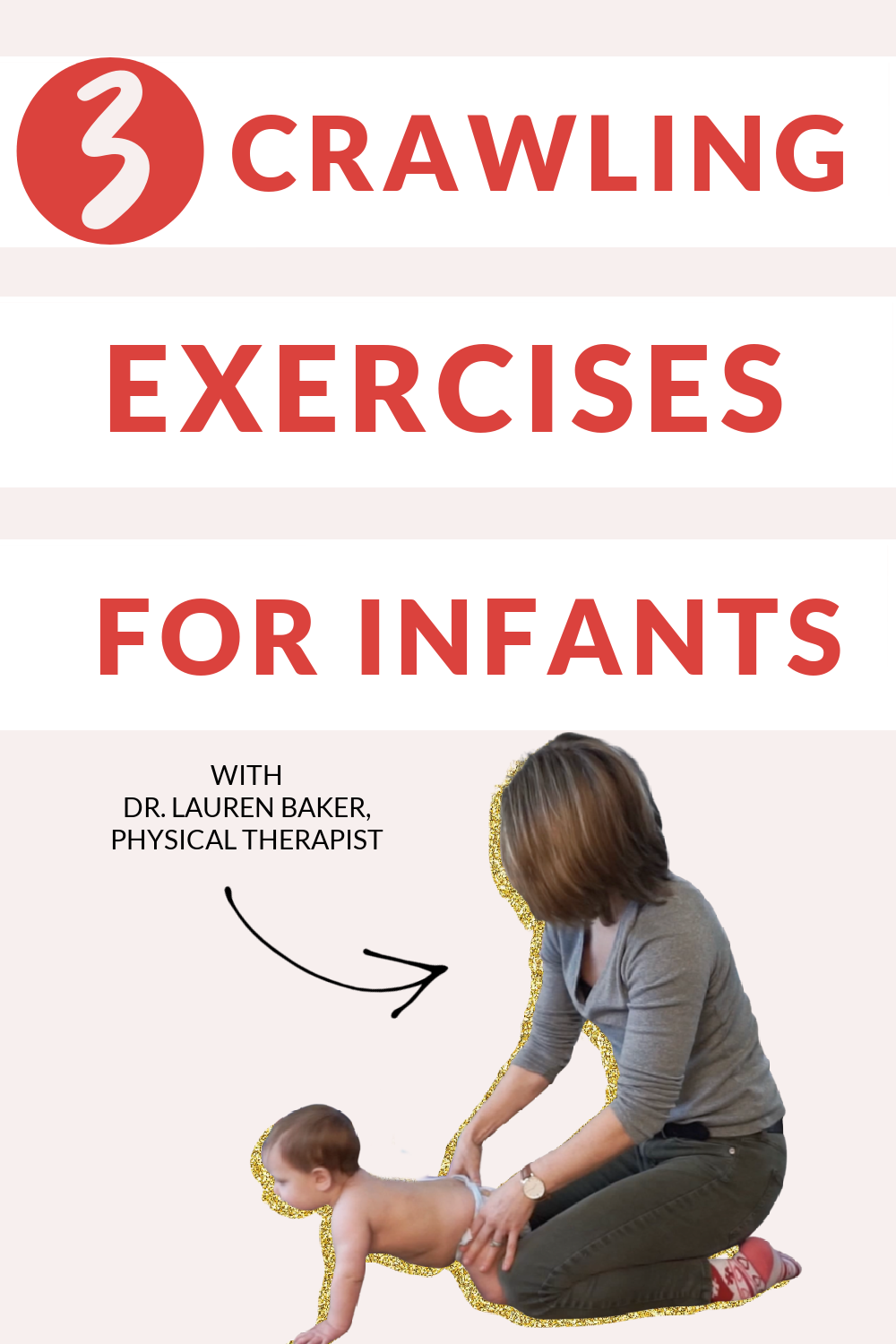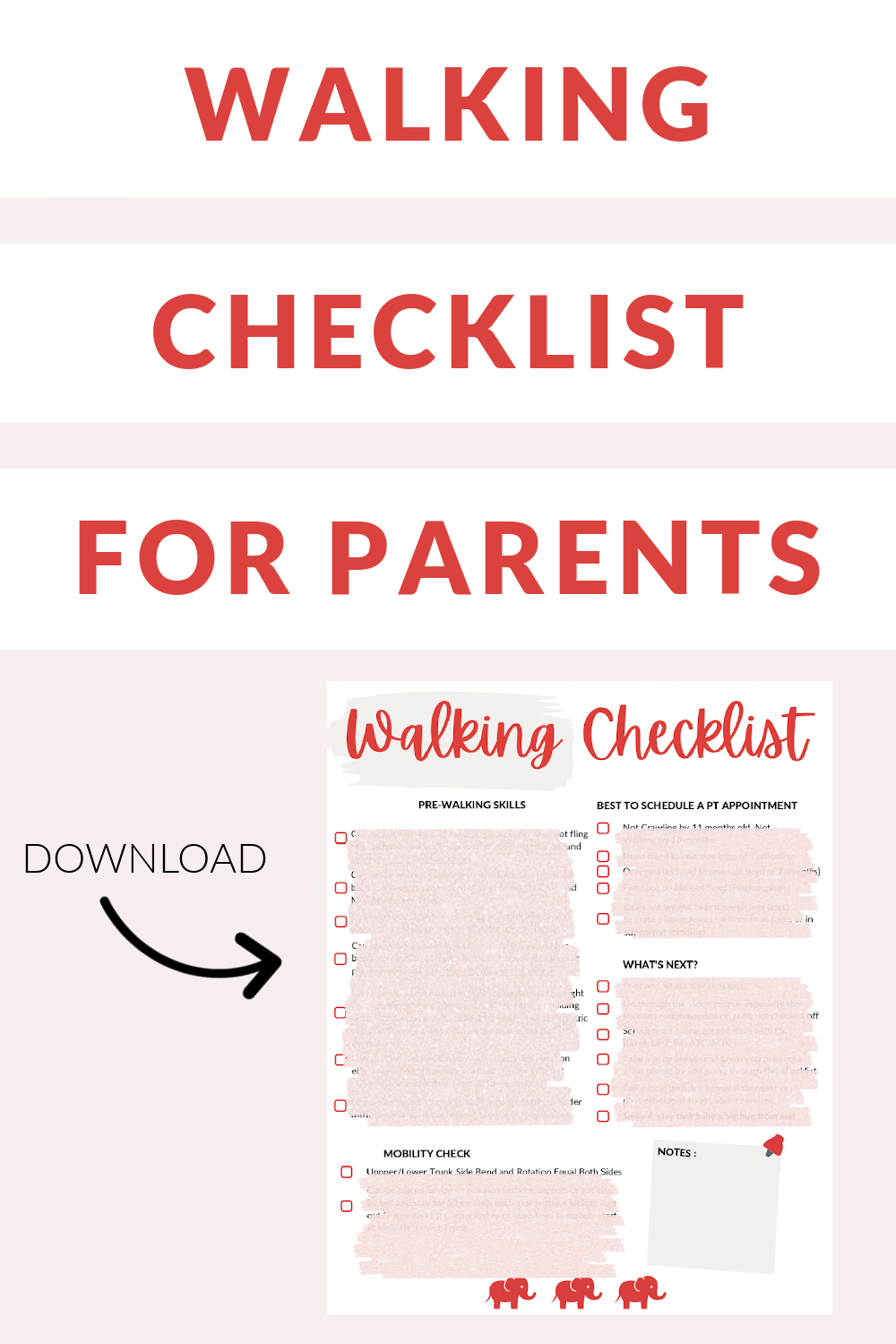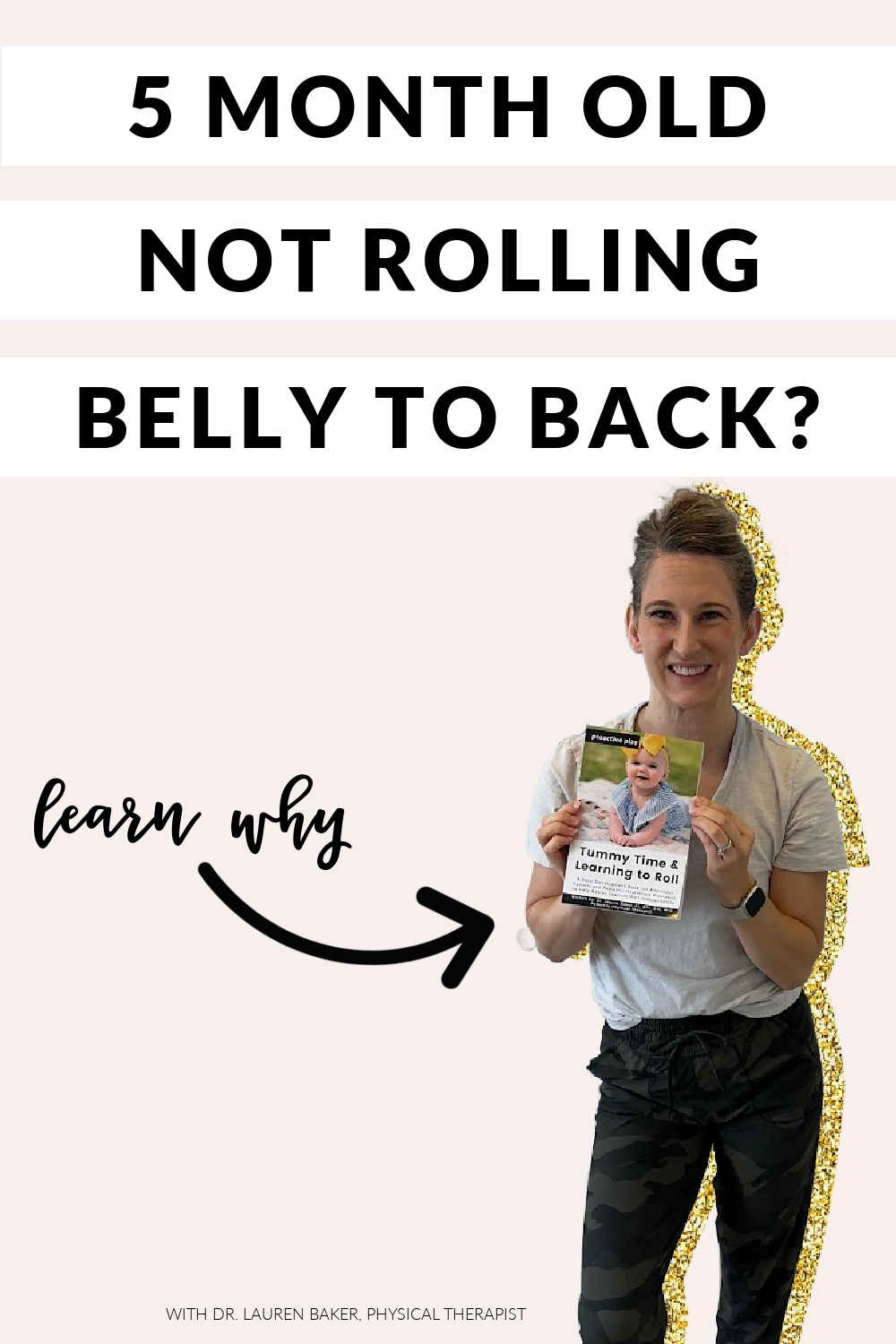How to Test A Baby’s Trunk Flexibility With This Rolling and Crawling Exercise
this blog contains affiliate links
Hello there, proactive parents! I'm Dr. Lauren Baker, a pediatric physical therapist, here to share some valuable insights into your baby's development.
Think of me as your pediatric PT bestie for all things related to helping your little ones move with confidence and ease. Today, we're diving into a topic that's both fascinating and crucial for your baby's growth: trunk mobility.
To be honest, it sounds kind of boring, but let me tell you – once you know about it, you will be able to unlock secret, hidden blocks that your baby might be experiencing if rolling or crawling is a struggle.
So, let's get started on this journey together!
Introduction to Trunk Mobility in Babies
You might not realize it, but trunk mobility is a big deal for babies. It's the foundation upon which many gross motor milestones like rolling, sitting, crawling, and walking are built.
However, many parents aren't aware that babies can have restrictions in their trunk, leading to a preference for moving in one direction or not being able to access the motion necessary in both directions, causing them to stay in one position like sitting or lying on their back.
This can cause muscle imbalances and make those milestones especially rolling and crawling more challenging than necessary.
Why It Matters to Test A Baby’s Trunk Flexibility
Muscle Imbalances: Tightness in the trunk can lead to asymmetrical movement patterns (this means that one side moves well, while the other doesn’t), potentially impacting your baby's ability to reach milestones smoothly. This can also occur globally if babies are tight in both directions.
Gross Motor Milestones: Proper trunk mobility is essential for rolling back to belly and belly to back, sitting independently, crawling, and eventually walking.
Quick Trunk Mobility Test: Elbow to Knee
For the most comprehensive information and examples on a baby please watch the youtube video below.
I'm excited to share a simple mobility test that you can do at home to check for trunk tightness or decreased mobility in your infant. This test can reveal if there's a significant difference in mobility from one side to the other.
How to Perform the Infant Trunk Mobility Test
Positioning: Gently place your baby on their back, then grasp under their left knee with one hand and behind their elbow with your other.
Movement: Gently hold beneath your baby's elbow and try to touch it to the opposite knee, only going as far as their resistance allows (never pushing past their resistance and always stopping when there is no more slack available).
Notice the motion of the knee coming to the elbow occurs at your baby's pelvis not their actual hip joint. The bottom of the baby should lift up into flexion (baby’s back and bottom are rounded).
Observation: Notice if one side seems easier or more difficult for your baby compared to the other. If one side the elbow and knee easily come together, touching or almost touching but the opposite is 3-4 inches a part, note the side that is difficult and approximately how far away the knee is from the elbow.
TIMESTAMPS:
2:32 Test for Babys Trunk Flexibility
3:14 indepth breakdown of how to complete the test
4:27 what this means and how it could impact crawling or rolling
TOY IDEAS:
Best Toys for Babies Learning to Roll
Best Toys for Babies
PT Approved Equipment/Containers for Babies
Tummy Time Toys
Understanding the Infant Trunk Mobility Test Results
If you find that there's a noticeable difference between the two sides, it might indicate trunk restrictions. This doesn't mean your baby won't hit their milestones, but they might face more difficulties.
It is important to note trunk restrictions, especially if a baby if struggling with a functional task, in their cases movement milestones like rolling, sitting, crawling, or walking.
What Differences Mean and How to Break Them Down
Every child is different, so the follow is a typical understanding of movement limitations; however, not every single child will present this way and it’s important to note how your child is moving and if there is any tightness present AND difficulty with milestones, to reach out to a pediatric PT to further assist in resolving.
Right Elbow – Left Knee is difficult or not as close: This is likely due to decreased range of motion or mobility in the right rotation of the upper trunk and/or left side bend of the lateral trunk (upper and/or lower trunk).
Babies may experience difficulty with:
Back to belly over the left arm
Belly to back over the right arm
Pivoting on their belly to the left
Sit to all fours to the right
Crawling on all fours
They may also present with Hitch crawling with R foot on the ground and L knee on the ground
Left Elbow – Right Knee is difficult or not as close: This likely is due to decreased range of motion or mobility in the left rotation of the upper trunk and/or right sidebend of the lateral trunk (upper and/or lower trunk).
Babies may experience difficulty with:
Back to belly over the left arm
Belly to back over the right arm
Pivoting on their belly to the right
Sit to all fours to the left
Crawling on all fours
They may also present with Hitch crawling with L foot on the ground and R knee on the ground
Both are difficult or pretty far apart > 1 inch: Babies may show difficulty in back to belly / belly to back / crawling / or transitioning in/out of all fours. They may also be okay with one direction but not all directions ie back to belly or belly to back over one arm but not in all four directions (belly to back over R arm, belly to back over L arm, back to belly over R arm, back to belly over L arm).
They may also present with booty scooting or prolonged army crawling, because these positions do not require side to side (side bend) or rotation directions.
If You Notice Asymmetries
Seek Professional Help: A pediatric physical therapist can provide hands-on assessment and personalized strategies for babies or speaking to a pediatric physical therapist through an online parent consultation can help you understand the movement that your child is presenting with and assist in finding either proactive play strategies or providers in your area.
Don't Panic: Consider any limitations as a data point to be proactive rather than a cause for alarm. Often, these “tests” are orthopedic in nature indicating that the baby is struggling with muscle tightness, not necessarily difficulty in coordinating the movement together.
Pediatric physical therapists can help you figure out any red flags for development if you do have more global concerns.
The Impact of Infant Trunk Mobility on Development
Restrictions in trunk mobility can influence various developmental milestones because these activities require multi-plane movements, such as rotating the trunk while also bending at the trunk, while fighting gravity.
Rolling is the most specific milestone in which trunk rotation and side bending can significantly limit a baby’s experience and achievement of movement milestones. See the Learning to Roll book, that I released in October 2023 for a comprehensive guide to improve trunk mobility and master tummy time and rolling in all four directions.
When a baby is beginning to sit independently they need trunk mobility is key to maintaining balance and posture, trunk mobility allows the muscles to turn on and off in sequence during different demands of gravity such as reaching to the front or side.
When babies move from their back to sitting and sitting to all fours, they need both side bending and rotation in order to do it. Most babies who struggle with rotation, begin to choose alternative, disadvantageous movement patterns such as booty scooting instead of crawling on all fours.
This is often due to them not having the available movement and with focused intention and support, they can often achieve crawling on hands and knees.
If you're concerned about your baby's trunk mobility or just want to ensure they're on the right track, remember, I'm here to help, you can schedule an online parent consultation at any time.
Curious About Learning More on Tummy Time, Rolling, or Both?
The absolute best book for parents on tummy time and rolling is: Tummy Time and Learning to Roll: A Baby Development Book for Ambitious Parents and Pediatric Healthcare Providers to Help Babies Learn to Roll Independently. The book comes with a free online video course to help parents fully understand how to complete the different exercises, printable checklists to know exactly where your baby is at, and when to reach out for additional help.
This book was written by Dr. Lauren Baker, PT, DPT, ATC, MTC, who is a Pediatric Physical Therapist in Boise, Idaho, trained in helping parents learn how to help their babies move and master their milestones. She loves teaching parents how to see how their babies are moving as well as how to influence those movements though play positions and exercises to help babies move with confidence and ease.
Tummy Time and Learning to Roll is the first book in the Proactive Play series written by Pediatric Physical Therapist Dr. Lauren Baker in order to help Ambitious Parents and Pediatric Healthcare Providers learn how to help babies master tummy time and learn to roll. It is meant to help ambitious parents understand baby development from birth to six months (tummy time to rolling).
This book is a mix of easy-to-follow and more in-depth information than is typically found in baby development books because Dr. Baker believes parents deserve to have all the information at their fingertips.
This book breaks down each piece of movement in checklists so that parents know what their babies need for tummy time and rolling. It also covers what areas might limit a child with rolling, why it is so important, and when to seek help from a pediatric PT.
This book comes with colored photos and easy-to-follow demonstration videos that can help parents implement safe, strategic play-based exercises with their babies in 20 minutes per day.
A Great Resource For:
Parents and Pediatric Healthcare Providers of babies 0-6 months
Parents of babies who are struggling with tummy time, rolling back to belly, belly to back, or only to one side
Access to simple, easy-to-follow videos of play positions and exercises
Learning the four pillars of movement needed in order to master rolling
240+ Color Photo Examples of:
Tummy Time, Sidelying, and Back Play
Developmental Toys and Equipment
Hand Placement and Strategic Play Positions
Common Areas of Restriction or Weakness
When To Reach Out For Help
What If You Want Extra Help?
If you have concerns about their movement, remember, you can always reach out to a pediatric physical therapist. It's your right as a parent to advocate for your child's development.
Sometimes, a few tips and tricks are all you need to get your baby moving better. We're here to support you and release those mama worries. If you are looking for in home pediatric physical therapy, check our listing of therapists.
For those eager to learn more or seeking personalized guidance, I offer online video parent consultations internationally which can be scheduled by clicking here. I am dedicated to answering questions and providing tailored play activities for each unique developmental journey.
When Should Babies Receive Pediatric Physical Therapy?
Parents can call and schedule with a Pediatric Physical Therapist at any time, for any concern in all fifty states without a referral from their Pediatrician.
Pediatric Physical Therapy is medically indicated in all babies who are not rolling in all four directions by six months (back to belly over their right arm AND left arm + belly to back over their right arm AND left arm).
Pediatric Physical Therapy is medically indicated if you notice a flat spot on the back of an infants head (possible plagiocephaly), a tilt of their head consistently to one side (ear to shoulder - possible torticollis), or a rotation preference of their neck (consistently look only to the right or left - possible torticollis).
Many Pediatric Physical Therapists including Dr. Baker, can successfully treat flat spots (Plagiocephaly) without a helmet with a combination of therapy and positioning strategies if seen prior to 4 months (0-3 months is ideal). Dr. Baker uses the Baby Begin Method of repositioning.
Flat spots can be due to in-utero positioning, rotational preference (right sided flatness most common) and babies are at an increased risk for flatness if they are male, were breech, multiple birth, premature, have difficulty with tummy time, or are in containers > 2 hr/day.
Final Thoughts
Your role in your baby's developmental journey is monumental, and by being proactive, you're setting the stage for their future success. If you have any questions or need guidance, feel free to reach out. If you haven’t yet, please consider subscribing to the youtube channel or share it with a parent friend.
Together, we can ensure your baby moves with confidence and joy!
Thank you for joining me today, and remember, you're doing an incredible job as a parent. Stay tuned for more tips and insights to support your baby's growth and development!
Total Motion Release for Babies: Relieve Infant Tension to Improve Motor Milestones
this blog contains affiliate links
Hello there! I'm Dr. Lauren Baker, a pediatric physical therapist. Through this blog, I'm excited to share with you an effective technique known as Total Motion Release (TMR) that I've found incredibly beneficial for babies. My aim is to guide proactive parents like you in helping your little ones release tension and move with ease. Consider me your physical therapy bestie helping you help your babies move well.
What is Total Motion Release (TMR)?
Total Motion Release is a concept that is based in osteopathic medicine called the modified strain counterstrain principle. In simpler terms, it's about shortening a muscle to help it relax, thereby gaining range of motion in the opposite direction.
This technique is gentler than traditional stretching methods, which involve lengthening the muscle, creating that resistance you feel in your muscles when you stretch. In TMR, we do the opposite - we shorten the muscle, which is especially effective for babies due to its gentle nature.
Traditional stretching sometimes is less effective in infants, because when they feel the resistance of a tight muscles being “stretched” or “lengthened,” they may interpret that as dangerous and instead of relaxing, they can tense up.
Modified strain counterstain principles such as total motion release, use a positional release construct where you ONLY shorten the muscle, going into the easy direction or side, which allows the babies to continue to say calm and relaxed, since they are not feeling that resistance.
It sounds counter-intuitive but truthfully, it often achieves amazing and often quick results.
Why TMR for Babies?
Gentleness: It's far gentler compared to stretching, making it ideal for infants.
Effectiveness: It achieves the same goal of increased range of motion but in a more comfortable way for the baby.
Upper and Lower Trunk Rotation in TMR
In today's post, we'll focus on the upper and lower trunk rotation aspects of TMR. Babies bodies need to be able to twist in opposite directions equally. Their upper half of their body needs to go to the right, while their lower half of their body goes to the left easily as well as the opposite of those directions.
Think of wringing out a wet towel, you twist your right hand and left hand in opposite directions to squeeze out the water. Babies' bodies need to be able to twist like that in order to achieve their milestones such as rolling over (both directions) and getting into all fours to crawl.
Before You Start
Professional Evaluation: Ensure your baby is evaluated by a licensed therapist (physiotherapist or physical therapist) trained in TMR before trying these techniques. Total Motion Release for babies taught by Susan Blum, utilizes multiple principles. This video covers one simple positional release technique and should not be confused with Total Motion Release as a treatment option. To find a therapist trained in total motion release, please search here.
Direction of Ease: Your therapist will guide you on the correct direction of rotation for your baby. For positional release techniques using the TMR principles, you will ONLY hold the direction of ease.
The Techniques: watch the video down below to ensure that you are doing it correctly and to learn even more in detailed why this technique works well for infants.
Upper Trunk / Lower Trunk TMR Technique
Positioning: One hand supports under the baby's arms around their chest, and the other hand goes through the baby's legs with your hand being placed on their buttocks that is the same side as the arm you are using (if your right arm is around their chest, you will rest your hand on their right buttocks/pelvis and vice versa) .
Rotation: Gently rotate the baby's upper and lower trunk in the direction of ease by bringing the elbow of the arm that is through the legs backwards and holding their trunk steady against your chest. Only complete to the level of resistance and not past.
Duration: Spend 1-3 minutes in this position, depending on the baby’s tolerance and then follow up with 30 seconds to 1 minute of bouncing to “lock in” the newly gained motion.
TIMESTAMPS:
1:03 what is total motion release (TMR)
2:53 why the total motion release technique for babies is ideal for increasing range of motion
4:29 what not to do when using total motion release techniques for babies
5:09 what to do if a baby switches directions
5:37 RR upper trunk / LR lower trunk total motion release technique
7:13 LR upper trunk / RR lower trunk total motion release technique
8:17 safety tips and explanation of tmr upper twist lower twist technique
10:03 additional tips for upper twist lower twist TMR tots release technique
TOY IDEAS:
What Not to Do
Avoid Both Sides: Don’t work on both sides as you would in stretching. Stick to the direction of ease as advised by your therapist. If you do both sides, it isn’t as effective and instead of completing a positional release using TMR principles, you would be completing traditional stretching.
Handling: Always handle the baby gently, focusing on the pelvis and lower back, not the hip joints.
Additional Tips
Movement: Feel free to gently bounce or move around during the technique. I often bring them toward a window or walk around with them in my arms throughout the house.
Observation: Watch for the baby's cues. If they show discomfort, ease off. Never hold a baby in a position if they are trying to kick out of it, always allow them to move out of the position and then once they are calm, re-attempt.
Frequency: Aim for a 2-minute session followed by 30 seconds of gentle bouncing.
Curious About Learning More on Tummy Time, Rolling, or Both?
The absolute best book for parents on tummy time and rolling is: Tummy Time and Learning to Roll: A Baby Development Book for Ambitious Parents and Pediatric Healthcare Providers to Help Babies Learn to Roll Independently. The book comes with a free online video course to help parents fully understand how to complete the different exercises, printable checklists to know exactly where your baby is at, and when to reach out for additional help.
This book was written by Dr. Lauren Baker, PT, DPT, ATC, MTC, who is a Pediatric Physical Therapist in Boise, Idaho, trained in helping parents learn how to help their babies move and master their milestones. She loves teaching parents how to see how their babies are moving as well as how to influence those movements though play positions and exercises to help babies move with confidence and ease.
Tummy Time and Learning to Roll is the first book in the Proactive Play series written by Pediatric Physical Therapist Dr. Lauren Baker in order to help Ambitious Parents and Pediatric Healthcare Providers learn how to help babies master tummy time and learn to roll. It is meant to help ambitious parents understand baby development from birth to six months (tummy time to rolling).
This book is a mix of easy-to-follow and more in-depth information than is typically found in baby development books because Dr. Baker believes parents deserve to have all the information at their fingertips.
This book breaks down each piece of movement in checklists so that parents know what their babies need for tummy time and rolling. It also covers what areas might limit a child with rolling, why it is so important, and when to seek help from a pediatric PT.
This book comes with colored photos and easy-to-follow demonstration videos that can help parents implement safe, strategic play-based exercises with their babies in 20 minutes per day.
A Great Resource For:
Parents and Pediatric Healthcare Providers of babies 0-6 months
Parents of babies who are struggling with tummy time, rolling back to belly, belly to back, or only to one side
Access to simple, easy-to-follow videos of play positions and exercises
Learning the four pillars of movement needed in order to master rolling
240+ Color Photo Examples of:
Tummy Time, Sidelying, and Back Play
Developmental Toys and Equipment
Hand Placement and Strategic Play Positions
Common Areas of Restriction or Weakness
When To Reach Out For Help
What If You Want Extra Help?
If you have concerns about their movement, remember, you can always reach out to a pediatric physical therapist. It's your right as a parent to advocate for your child's development.
Sometimes, a few tips and tricks are all you need to get your baby moving better. We're here to support you and release those mama worries. If you are looking for in home pediatric physical therapy, check our listing of therapists.
For those eager to learn more or seeking personalized guidance, I offer online video parent consultations internationally which can be scheduled by clicking here. I am dedicated to answering questions and providing tailored play activities for each unique developmental journey.
When Should Babies Receive Pediatric Physical Therapy?
Parents can call and schedule with a Pediatric Physical Therapist at any time, for any concern in all fifty states without a referral from their Pediatrician.
Pediatric Physical Therapy is medically indicated in all babies who are not rolling in all four directions by six months (back to belly over their right arm AND left arm + belly to back over their right arm AND left arm).
Pediatric Physical Therapy is medically indicated if you notice a flat spot on the back of an infants head (possible plagiocephaly), a tilt of their head consistently to one side (ear to shoulder - possible torticollis), or a rotation preference of their neck (consistently look only to the right or left - possible torticollis).
Many Pediatric Physical Therapists including Dr. Baker, can successfully treat flat spots (Plagiocephaly) without a helmet with a combination of therapy and positioning strategies if seen prior to 4 months (0-3 months is ideal). Dr. Baker uses the Baby Begin Method of repositioning.
Flat spots can be due to in-utero positioning, rotational preference (right sided flatness most common) and babies are at an increased risk for flatness if they are male, were breech, multiple birth, premature, have difficulty with tummy time, show signs of Torticollis (tilt/rotation preference) or are in containers > 2 hr/day.
Final Thoughts
I hope this guide helps you understand and apply the Total Motion Release technique for your little one. It's essential to always prioritize gentleness and follow the guidance of a trained professional. If you have questions or want to learn more about pediatric mobility, feel free to reach out or schedule a consultation with me.
Remember, every baby's journey is unique, and your proactive approach in understanding and aiding their movement is invaluable. Stay tuned for more insights and tips on various stages of your baby's movement development – crawling, walking, rolling, and more!
Look down below for more resources on rolling or click on the blog post page if your baby is working on a different milestone such as crawling.
And that's it, friends! If you find this helpful, let me know in the comments of the youtube video. I love interacting with parents committed to their children's well-being. Here's to a journey of gentle, effective proactive play for your little ones! 🌟
Walking
this page contains affiliate links
Curious About Learning More on How To Teach Babies To Walk Without Support?
The absolute best resource for parents on helping their babies learn to walk with and without support is the free online course: Learning to Walk by Dr. Baker.
To gain immediate access to the online course, click the link above, submit your information, and the online course instructions will be emailed to you directly.
The free online video course is designed to help parents fully understand how to help their children walk with and without support and trouble shoot what building block of walking the child might not have mastered yet.
It comes with video examples of exercises, printable checklists to know exactly where your baby is at, and information on when to reach out for additional help.
This online course was created by Dr. Lauren Baker, PT, DPT, ATC, MTC, who is a Pediatric Physical Therapist in Boise, Idaho, trained in helping parents learn how to help their babies move and master their milestones.
She loves teaching parents how to see how their babies are moving as well as how to influence those movements though play positions and exercises to help babies move with confidence and ease.
It is meant to help ambitious parents understand baby development from 9-18 months (getting in/out of standing, cruising/walking with support to independent walking).
This online course breaks down each piece of movement in checklists so that parents know what their babies need for walking and it also covers a checklist to make sure babies have mastered crawling (otherwise, this could be a reason why walking is still a struggle!)
It also covers what areas might limit a child with walking, how to get in/out of standing, how to walk with and without support, and when to seek help from a pediatric PT.
This online course can help parents implement safe, strategic play-based exercises with their babies in 20 minutes per day.
A Great Resource For:
Parents and Pediatric Healthcare Providers of babies 9-18 months
Parents of babies who are struggling with getting in/out of standing or walking with/without support
Access to simple, easy-to-follow videos of play positions and exercises
Learning the four pillars of movement needed in order to master walking independently
8 Online Course Modules
Building Blocks of Walking
Walking Checklists + Shoe Guides
Getting Into Standing
Cruising and Walking With/Without Support
Strength Exercises
Mobility Exercises
Walking Specific Play Exercises
Next Steps: How to Prep for Jumping & Climbing
What If You Want Extra Help?
If you have concerns about your baby’s ability to pull into standing, cruise (walking while holding onto furniture), or walking independently without support, remember, you can always reach out to a pediatric physical therapist.
It's your right as a parent to advocate for your child's development. Sometimes, a few tips and tricks are all you need to get your baby moving better.
I’m here to support you and release those worries.
For those eager to learn more or seeking personalized guidance, I offer online video parent consultations internationally and Pediatric Physical Therapy in Boise, ID and the Treasure Valley – which you can learn more about by scheduling a free 20 minute chat with me (Idaho only) or an online parent consultation by clicking here.
I am dedicated to answering questions and providing tailored play activities for each unique developmental journey.
When Should A Child Receive Pediatric Physical Therapy?
Parents can call and schedule with a Pediatric Physical Therapist at any time, for any concern in all fifty states without a referral from their Pediatrician.
Pediatric Physical Therapy is medically indicated in all babies who are not walking on their own without support by 18 months. Proactive Pediatric Physical Therapy recommend if a child is not walking on their own by 16 months.
Pediatric Physical Therapy is medically indicated if you notice a flat spot on the back of an infants head (possible plagiocephaly), a tilt of their head consistently to one side (ear to shoulder - possible torticollis), or a rotation preference of their neck (consistently look only to the right or left - possible torticollis).
Flat spots can be due to in-utero positioning, rotational preference (right sided flatness most common) and babies are at an increased risk for flatness if they are male, were breech, multiple birth, premature, have difficulty with tummy time, or are in containers > 2 hr/day. Flat spots can only be treated up until 18 months and success decreases after the age of 12 months.
Jumping
Approximately 6 months after walking independently, children will begin showing signs of attempting to jump on their own.
Once a child is 2-2.5 years old, they are typically able to jump forward 4-23 inches.
If a child is 2.5 years old and have been walking for > 6 months and they are not yet showing signs of jumping (up, down, and forward), there may be strength, power, or coordination skills that they need help acquiring.
One of my favorite ways to work on building lower leg strength and endurance is the toddler squat which can be done supported or having them do it on their own.
What If You Want Extra Help?
If you have concerns about your child’s ability to jump up, down, or forward with/without support, remember, you can always reach out to a pediatric physical therapist.
It's your right as a parent to advocate for your child's development. Sometimes, a few tips and tricks are all you need to get your child moving and more confident in their coordination.
I’m here to support you and release those worries.
For those eager to learn more or seeking personalized guidance, I offer online video parent consultations internationally and Pediatric Physical Therapy in Boise, ID and the Treasure Valley – which you can learn more about by scheduling a free 20 minute chat with me (Idaho only) or an online parent consultation by clicking here.
When Should A Child Receive Pediatric Physical Therapy?
Parents can call and schedule with a Pediatric Physical Therapist at any time, for any concern in all fifty states without a referral from their Pediatrician.
Pediatric Physical Therapy is medically indicated in children who are showing significant signs of struggle with jumping at 2.5 years, are not jumping forward 4 inches by 3 years, not jumping down from a 12 inch height and landing with both feet at the same time by 3 years, or not jumping 1-2 inches off the ground by 3 years.
Stairs
Climbing skills begin as babies, when they crawl over objects on the floor and get on/off of elevated surfaces such as play equipment or a couch/chair.
Babies who skip crawling are at risk for having difficulty with climbing up and down stairs as they did not have the hip, leg, and core strengthening opportunities of their crawling peers.
Children who always lead with one foot when going up the stairs and with the other foot when going down stairs are potentially showing signs that one side of their body is stronger or more balanced than the other.
For example, if a child uses their right leg when going up the stairs and their left leg going down the stairs, their right leg is potentially stronger than their left leg. If they can do the opposite direction when prompted, there is less concern, but if they refuse or cannot without assistance, the left leg may be weaker than the right.
Children should be able to walk up stairs without holding on by 2.5 years (either with one foot or two feet on a step).
Typically, children should be able to walk up with either leg when prompted using one foot on each step by 3-3.75 years of age.
If a child is struggling with stepping up with one leg but not the other, try this activity to increase strength and confidence in the leg they tend to avoid using.
What If You Want Extra Help?
If you have concerns about your child’s ability to climb up or down stairs with/without support, remember, you can always reach out to a pediatric physical therapist.
It's your right as a parent to advocate for your child's development. Sometimes, a few tips and tricks are all you need to get your child moving and more confident in their coordination.
I’m here to support you and release those worries.
For those eager to learn more or seeking personalized guidance, I offer online video parent consultations internationally and Pediatric Physical Therapy in Boise, ID and the Treasure Valley – which you can learn more about by scheduling a free 20 minute chat with me (Idaho only) or an online parent consultation by clicking here.
When Should A Child Receive Pediatric Physical Therapy?
Parents can call and schedule with a Pediatric Physical Therapist at any time, for any concern in all fifty states without a referral from their Pediatrician.
Pediatric Physical Therapy is medically indicated in children who are showing significant signs of struggle with stairs at 2 years, are not going up/down stairs with support using both legs by 2.5 years (either with one foot or two feet on a step), not walking up stairs with one foot on each step without support by 3 years, or not walking down stairs with one foot on each step without support by 4 years of age.
Throwing & Catching
If a child is having difficulty with throwing/catching, it could be due to difficulty with coordinating their eyeballs!
When a ball comes toward a child, their eyeballs need to come together in order for them to accurately catch a ball.
If you notice a child closing their eyes as the ball comes toward them, they do not yet have the coordination of their eyeballs coming together, so they close their eyes instead.
This decreases their accuracy and often the ball will bounce off their chest or arms instead of them catching it.
try this activity with your child to train their eyeballs (kids love it! and you can even have them do it to you too!).
What If You Want Extra Help?
If you have concerns about your child’s ability to throw a ball overhand, underhand, or catch a ball, remember, you can always reach out to a pediatric physical therapist.
It's your right as a parent to advocate for your child's development. Sometimes, a few tips and tricks are all you need to get your child moving and more confident in their coordination.
I’m here to support you and release those worries.
For those eager to learn more or seeking personalized guidance, I offer online video parent consultations internationally and Pediatric Physical Therapy in Boise, ID and the Treasure Valley – which you can learn more about by scheduling a free 20 minute chat with me (Idaho only) or an online parent consultation by clicking here.
I am dedicated to answering questions and providing tailored play activities for each unique developmental journey.
When Should A Child Receive Pediatric Physical Therapy?
Parents can call and schedule with a Pediatric Physical Therapist at any time, for any concern in all fifty states without a referral from their Pediatrician.
Pediatric Physical Therapy is medically indicated in children who are not throwing/catching by 3-4 years old.
Prevent Avoidable Motor Delays: How To Test Your Baby's Trunk Mobility
this blog contains affiliate links
Hello! I'm Dr. Lauren Baker, a pediatric physical therapist. Today, I'm thrilled to share insights on one of the most crucial aspects of your baby's development - trunk rotation. This aspect of movement plays a pivotal role in milestones like rolling, sitting, crawling, and walking and it’s one of the least known aspects of movement and baby development in the parent world. Today, we are going to change that!
Why Is Upper Trunk Rotation Important?
Upper trunk rotation is essential for your baby's overall mobility. It's the foundation for many activities, including the ability to roll over, going from lying on the ground to sitting up, going from sitting to crawling, and it is even needed when we walk.
When we talk about trunk rotation, we're referring to the upper half of the body moving independently from the lower half, this of sitting in a chair and twisting your shoulders to look behind you (your upper half is moving but your lower half isn’t). This movement is crucial for maintaining our position against gravity, for getting in and out of positions, and for combining motions which we need for complex movements like walking and crawling.
Assessing Trunk Rotation in Babies
To ensure your baby is developing symmetrically and has mobility equally side to side, it's vital to assess their upper trunk rotation. When doing this, we're looking for equal movement on both sides. A limitation on one side can affect how your baby moves, potentially leading to preferences that might impact their development down the line.
Tightness in one direction can also lead to avoidance of movement in that direction, which is often why you see babies choose to only roll to one side (if we know what is limiting them, we can help them fix it! And then they can roll equally to both sides).
Baby Mobility Exercises: Enhancing Trunk Rotation
To encourage healthy trunk rotation in your baby, first try to see if your baby’s upper trunk can go equally in both directions. While they are sitting between your legs, gently move their upper body from forward to the right, stopping when you feel resistance (this is as far as you should go) and then forward to the left, again stopping when you feel resistance.
Watch the video below start to finish for the most comprehensive explanation and demonstration or click on the hyperlink to go directly to the exercise to watch in order to make sure you do it correctly!
TIMESTAMPS:
1:27 why upper trunk rotation and baby trunk rotation is important
4:52 straddle baby trunk rotation assessment
5:17 ring sit baby trunk rotation assessment
6:23 baby between parent's legs baby trunk rotation assessment
TOY IDEAS:
Trunk Weakness in Babies: Spotting and Addressing It
If you notice that your baby struggles with trunk rotation (typically you will feel resistance or they will express displeasure in that direction) or they seem to favor one side, it might indicate trunk weakness or tightness. Weakness and tightness are often companions, as a tight muscle is also a weak muscle, so sometimes when we increase the range and resolve the tightness, we then have to strengthen those muscles.
However, if you do not notice your baby has tightness when doing the upper trunk screen, but they do still show a preference, they could have weakness in the muscles that are needed to go in the direction they are avoiding. Weakness can be associated with tightness or it can be the only thing affecting the child.
It's important to be aware if your baby is experiencing trunk weakness. Signs of this can include a lack of balance in sitting, difficulty in holding themselves up (normal sitting age is 6-9 months), or favoring one side (if their little body forms a “C” shape in lying down or sitting). If you notice any of these signs, incorporating specific exercises can help strengthen their trunk muscles, see the youtube core strengthening playlist here.
What Is a Baby's Trunk, and Why Is Its Control Vital?
The trunk is the body's core, including the chest and abdomen. Trunk control is essential for stability and forms the basis of all movement. A strong trunk enables your baby to explore the world more confidently. Babies need full mobility of their trunk in order to build or access the full strength of their core, which is why assessing upper trunk rotation in infants is so important.
Regularly assessing your baby's trunk control (strength and mobility) can provide valuable insights into their development. Look for whether they have mastered rolling back to belly (right and left), belly to back (right and left), how well they hold themselves up when sitting, their reactions to gentle movements (do they throw themselves back or collapse forward when sitting), and their ability to engage in playful activities that involve twisting, such as bringing both hands to one side in sitting.
Crossing the Midline: A Cognitive and Physical Milestone
An interesting aspect of trunk rotation is its connection to cognitive development. When babies learn to cross the midline (bringing both hands from one side of the body to the other), they're not only enhancing their physical abilities but also strengthening neural pathways in the brain.
These pathways help with future academic milestones such as reading and writing. When babies have trunk tightness, they might avoid crossing midline in one or both directions, which can decrease their opportunities to develop and strengthen these pathways. This can lead to them being at a disadvantage compared to their same age, non-restricted peers.
Pediatric Physical Therapy Exercises for Babies
Incorporating pediatric physical therapy exercises into your baby's routine can be a game-changer. Simple activities like rolling over exercises and trunk control exercises can boost their development significantly.
Making sure that you resolve any tightness by completing the associated releases/stretches is equally important. If you ever find that the tightness is not resolving or you need assistance, reaching out to a local pediatric physical therapist can be the best, most effective thing for you and your baby. See our list of mobile pediatric physical therapists here.
Trunk Movement in Infants: Encouraging Healthy Development
Encouraging various trunk movements is key to your baby's development. This includes exercises that promote rotating, an easy switch in most families routines is to place toys to the side of the child instead of always in front.
This encourages the child to reach to the side and also bring both hands to the side (rotating at their trunk) in order to manipulate or grab the toy. It’s okay to start with the easy side and then build up to adding in the hard side (or assisting with the hard side and letting them do the easy side). Each of these movements contributes to a well-rounded and robust physical development.
Curious About Learning More on Tummy Time, Rolling, or Both?
The absolute best book for parents on tummy time and rolling is: Tummy Time and Learning to Roll: A Baby Development Book for Ambitious Parents and Pediatric Healthcare Providers to Help Babies Learn to Roll Independently. The book comes with a free online video course to help parents fully understand how to complete the different exercises, printable checklists to know exactly where your baby is at, and when to reach out for additional help.
This book was written by Dr. Lauren Baker, PT, DPT, ATC, MTC, who is a Pediatric Physical Therapist in Boise, Idaho, trained in helping parents learn how to help their babies move and master their milestones. She loves teaching parents how to see how their babies are moving as well as how to influence those movements though play positions and exercises to help babies move with confidence and ease.
Tummy Time and Learning to Roll is the first book in the Proactive Play series written by Pediatric Physical Therapist Dr. Lauren Baker in order to help Ambitious Parents and Pediatric Healthcare Providers learn how to help babies master tummy time and learn to roll. It is meant to help ambitious parents understand baby development from birth to six months (tummy time to rolling).
This book is a mix of easy-to-follow and more in-depth information than is typically found in baby development books because Dr. Baker believes parents deserve to have all the information at their fingertips.
This book breaks down each piece of movement in checklists so that parents know what their babies need for tummy time and rolling. It also covers what areas might limit a child with rolling, why it is so important, and when to seek help from a pediatric PT.
This book comes with colored photos and easy-to-follow demonstration videos that can help parents implement safe, strategic play-based exercises with their babies in 20 minutes per day.
A Great Resource For:
Parents and Pediatric Healthcare Providers of babies 0-6 months
Parents of babies who are struggling with tummy time, rolling back to belly, belly to back, or only to one side
Access to simple, easy-to-follow videos of play positions and exercises
Learning the four pillars of movement needed in order to master rolling
240+ Color Photo Examples of:
Tummy Time, Sidelying, and Back Play
Developmental Toys and Equipment
Hand Placement and Strategic Play Positions
Common Areas of Restriction or Weakness
When To Reach Out For Help
What If You Want Extra Help?
If you have concerns about their movement, remember, you can always reach out to a pediatric physical therapist. It's your right as a parent to advocate for your child's development. Sometimes, a few tips and tricks are all you need to get your baby moving better. We're here to support you and release those mama worries. If you are looking for in home pediatric physical therapy, check our listing of therapists.
For those eager to learn more or seeking personalized guidance, I offer online video parent consultations internationally and Pediatric Physical Therapy in Boise, ID and the Treasure Valley – by clicking to the appointment tab or by clicking here. I am dedicated to answering questions and providing tailored play activities for each unique developmental journey.
Final Thoughts: Empowering Your Baby’s Journey
Remember, every baby develops at their own pace, and what's important is providing them with opportunities to explore and strengthen their abilities. By incorporating these simple exercises and being mindful of their trunk rotation, you're setting your baby up for a lifetime of confident movement, as well as decreasing the risk of difficulty with crawling on hands and knees.

